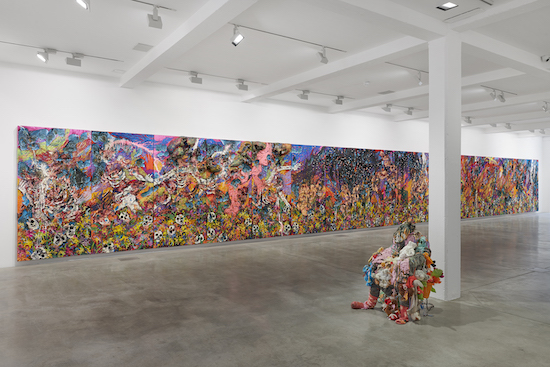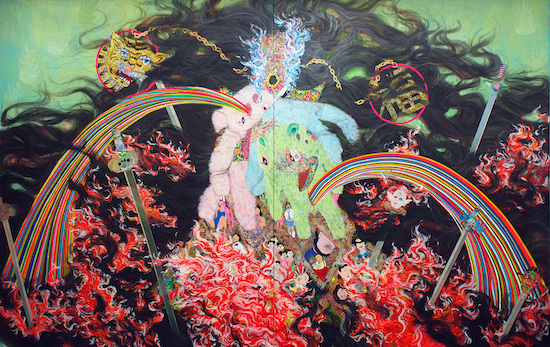There are creatures, demons and people. Terrible things are happening to them. A woman force-feeds another or possibly stoppers her mouth from disgorging vomit. A demon struts before an audience with their their heads in stocks, flailing a figure who is being scalded by a line of fire. Skeleton hands rub a bouquet of blooms as if drawing energy from their poxed petals. A double-headed chicken fights itself, and a creature that is half muskrat, half panda gets high sniffing blue and red tassels.
In the tortured and hallucinatory world of Hyon Gyon, art is principally a reaction to the deadening, male-dominated society of hyper-commercialised South Korea; the purpose of her baroque grotesqueries is to reveal and purge these evils. She considers the process of creating her art a kind of exorcism, a purgative performance. On display in her first solo public show in Europe are mixed media paintings and sculptures created during trance-like states which connect her with the invisible mechanism of the human realm. From the perspective of the Western canon, the trances she enters connect her to (and allow her to act out) unconscious desires and urges; from a specifically Korean perspective, she is associating herself with the tradition of female shamans (or mudang – typically they perform healing ministries and are considered low class). By immersing herself in a universalised spiritual state she is able to bring to light the uglinesses perpetrated within Korean society while also purging herself of its excrescences. She considers the eventual pieces cleansing – though the exhibition, which spans two floors, is a mêlée of horror, as compelling as it is inventive, as detailed up close as it is from afar.
Step back from the brutal miniatures and the forms are subsumed into larger shapes: a kaleidoscope-eyed acid totem with scored horns; a demon born from a bed of ornate flames bleeding sick rainbows and composed of discarded soft toys; a pink-faced genie escaping a diamanté skull only to to face abacination by a door-mouthed succubus. Sharp implements drawn from all spheres, from the military to the domestic – ornate war swords, overly-long fingernails, knitting needles, axes, fish hooks, arrows, pins and scissors – impale what might be heads. Gouts of hair abound, trailing like evil cirrus across the canvases, threatening to overwhelm their subjects and spill out past the canvas. Violence is perpetuated at all levels, forcing itself upon the viewer — the vast and granular creep of horrifying cruelty alike demanding ever-closer scrutiny.
Prosaically, this means pieces can look pretty from afar but on closer inspection resolve into nightmarish visions. It’s all aggressive, it all invites further scrutiny. We Were Ugly (2017) is a mixed media mural of vertical panels which runs along an entire wall of the first room. From far, textures glitter, glint and shimmer. Bright waves of colour dash themselves across the panels as if stirred by some tremendous generative energy. Jaunty pinks, yellows and greens abound round swollen fleshy masses, but the mural is a reflection on war, upheaval and national trauma in the Asian region – including the atomic bombs dropped on Japan – and the sickness of these events metastasises across its length, gradually taking up space with its growling, garish horror. Skulls strew the bottom third, surrounded by flowers nourished by the rotting bodies; glitter seasons their gritted canines. Slick black stalactites drip over caverns burned into the panels’ styrofoam innards. Daubs of oil paint shaft sharp points out of grated scores of ripped fabric like diseased alveoli. A flock of over-painted eyes made of gold-gauzed fabric flit across the centre. All seems hopeless – they look into you, but their pupils are empty, punched holes.

This burgeoning pictorial brutality is more shocking than her sculptures. The Last Man (2017) and Hello Another Me (2011) are composed of everyday objects (tights, kitchen gloves, stuffed toys, socks and fake flowers) strapped into fevered forms that transfix the everyday and lurch it into psychosis. Domestic environments and the realm of childhood provide rich material for dehumanising and unjust exertion of power. But while in painting and sculpture alike Hyon Gyon depicts both victims and torturers, nearly all are to some extent both. At each level, vicious manipulation is rampant. The swollen penis of The Last Man is tipped by a sore red plush bear, but the body itself – constructed of mundane newspapers over a chicken wire cage – is stripped and skeletal, covered with fungal cancers clumping parasitically along its calves, back and buttocks; one hangs like a goitre from a jowl. The figure looks like it should be in pain, but it merely occupies space, confronting us. It doesn’t allure and challenge, it doesn’t pose questions.
Another sculpture in a side room, Nobody cares about your misery (2018) exploits this ambivalence more fully. Gold dollar signs glare out of gaping eye-sockets, a chipped, noseless face of parched wood opens into a mouthy void populated with craggy, three dimensional molars. The painted hands of a dummy reach up to it in fake supplication and the plinth is steadied by a double rainbow of arched pigtails, jerry-rigged sausages of wire and miscellaneous material. The heterogeneous scraps and rags indicate the disposable nature of human wants and desires and their overwhelming tyranny, the impossibility of generating a wholly news, untainted being. Upstairs are mosaics and pieces of sgraffito (blocks of stone on which the design has been viciously scratched away). Mottos abound – and are not without humour: ‘Shut the fuck up’, ‘Life is shit and then you die’, ‘Kill’ and ‘Liar’ are written with fabric paint on boxing gloves growing off of a snakily coiled sausage rag tree (A Chain of Struggles (2018)). The Battlefield (2018) quotes Corinthians (“suppose the ear said ‘I am not an eye I do not belong to the body’”) and riffs on paternal cruelty and the terrible inevitability of procreation against the backdrop of the crucifixion and multi-generational trauma: “You are of your father,” intones a foetal crouched creature in a speech bubble, its loony scribbled face both haunting and absurd.
In Hyon Gyon’s strongest work, beauty is actively poisonous. Sinuous movements give way to acts of atrocity. Glitz draws viewers in, like consumerist dummies, and the style and rendering dictate viewers’ threshold for horror. The lingering question is whether, if she is purging these awful aspects of the invisible world, they reveal to their viewers the shape of hidden things or become just another passed-on atrocity to be purged. Does the ‘truth’ that they speak transcend the horror they depict and are? According to Hyon Gyon, these pieces are ways of escaping the pain of being; but as a viewer whether this is the case is less clear.
Dear Beloved (2018) is a bust of shattered tiles with crude lipstick-red features burlesquing a face slathered on. Behind the bust’s neck, delicate wax hands overlay each other, climbing the spine and supporting the neck. It’s almost tender – but for the top one which, spider-like, climbs the skull a little higher like a lopped panic attack. What appears sweet can always morph and each tile shard is another reminder that life’s pain is unremitting. And while pain can be purged, life is – for the moment at least – inescapable.
Hyon Gyon is at Parasol Unit, London, until 31 March


